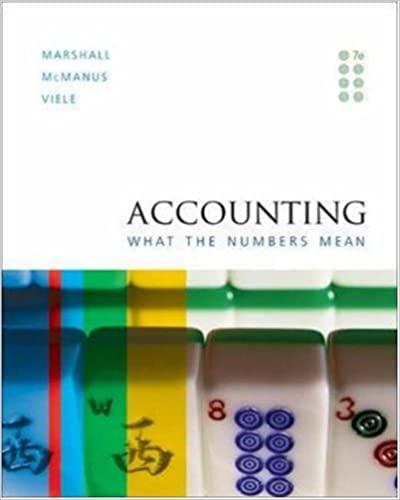Question
Laker Company reported the following January purchases and sales data for its only product. For specific identification, ending inventory consists of 340 units from the
Laker Company reported the following January purchases and sales data for its only product. For specific identification, ending inventory consists of 340 units from the January 30 purchase, 5 units from the January 20 purchase, and 15 units from beginning inventory.
DateActivitiesUnits Acquired at CostUnits sold at RetailJanuary 1Beginning inventory210units@$ 13.50=$ 2,835January 10Sales160units@$ 22.50January 20Purchase150units@$ 12.50=1,875January 25Sales180units@$ 22.50January 30Purchase340units@$ 12.00=4,080Totals700units$ 8,790340unitsThe Company uses a periodic inventory system. For specific identification, ending inventory consists of 340 units from the January 30 purchase, 5 units from the January 20 purchase, and 15 units from beginning inventory. Determine the cost assigned to ending inventory and to cost of goods sold using (a) specific identification, (b) weighted average, (c) FIFO, and (d) LIFO.
Determine the cost assigned to ending inventory and to cost of goods sold using specific identification. For specific identification, ending inventory consists of 340units from the January 30 purchase, 5units from the January 20 purchase, and 15units from beginning inventory.
a) Specific IdentificationCost of Goods Available for SaleCost of Goods SoldEnding Inventory# of unitsCost per unitCost of Goods Available for Sale# of units soldCost per unitCost of Goods Sold# of units in ending inventoryCost per unitEnding InventoryBeginning inventoryPurchases:January 20January 30Total0$00$00$0Determine the cost assigned to ending inventory and to cost of goods sold using weighted average. Note: Round cost per unit to 2 decimal places.
b) Weighted average - PeriodicCost of Goods Available for SaleCost of Goods SoldEnding Inventory# of unitsAverage Cost per unitCost of Goods Available for Sale# of units soldAverage Cost per UnitCost of Goods Sold# of units in ending inventoryAverage Cost per unitEnding InventoryBeginning inventoryPurchases:January 20January 30TotalDetermine the cost assigned to ending inventory and to cost of goods sold using FIFO.
c) Periodic FIFOCost of Goods Available for SaleCost of Goods SoldEnding Inventory# of unitsCost per unitCost of Goods Available for Sale# of units soldCost per unitCost of Goods Sold# of units in ending inventoryCost per unitEnding InventoryBeginning inventoryPurchases:January 20January 30Total0$0Determine the cost assigned to ending inventory and to cost of goods sold using LIFO.
d) Periodic LIFOCost of Goods Available for SaleCost of Goods SoldEnding Inventory# of unitsCost per unitCost of Goods Available for Sale# of units soldCost per unitCost of Goods Sold# of units in ending inventoryCost per unitEnding InventoryBeginning inventoryPurchases:January 20January 30Total0$0$0Step by Step Solution
There are 3 Steps involved in it
Step: 1

Get Instant Access to Expert-Tailored Solutions
See step-by-step solutions with expert insights and AI powered tools for academic success
Step: 2

Step: 3

Ace Your Homework with AI
Get the answers you need in no time with our AI-driven, step-by-step assistance
Get Started


